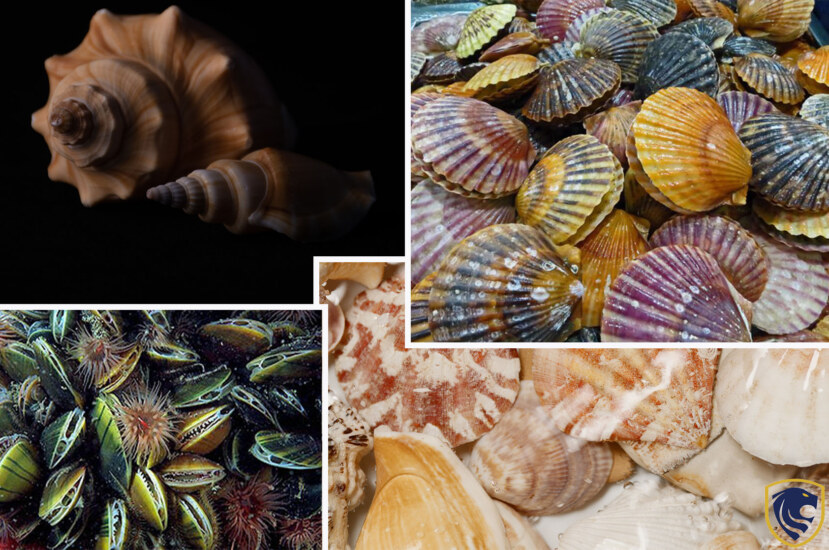The bivalve, one of the most fascinating groups of mollusks, is a fascinating creature that inhabits both freshwater and marine settings. They are characterized by their distinctive two-part hinged shells, which provide protection and support. These calcium carbonate-based shells are available in an amazing range of forms, dimensions, and hues. By pushing water through their gills, bivalves remove food particles from the water, making them filter feeders. By removing contaminants and extra nutrients, they are essential for preserving water quality. Some bivalves, like clams and oysters, are considered keystone species, as they provide important ecological services and habitats for other organisms.
These incredible creatures display a diverse range of specializations and behaviors. The capacity of some bivalves to swim by quickly opening and closing their shells is well known. Scallops are one such example. Others, such as mussels, form dense colonies by attaching themselves to rocks, pilings, or each other.
Bivalves have been around for millions of years and have successfully adapted to various ecosystems worldwide. They have played significant roles in human culture and history, being a source of food, pearls, and even tools in ancient times.
The diversity of bivalve species is astounding. From the flamboyant Flame Scallop to the elegant Venus Comb Murex, these creatures showcase a remarkable array of shapes, patterns, and colors.
The Flame Scallop (Lima scabra)

The Flame Scallop (Lima scabra)
One of the most stunning bivalve species in the entire world is the Flame Scallop (Lima scabra), which is well known for its beauty. Its stunning color combination and complex patterns are what give it its alluring charm. The scallop’s shell features an enthralling combination of vivid red, orange, and occasionally pink colors. Moreover, the species gets its common name from the hues, which are suggestive of flickering flames. The scallop’s shell has delicate patterns that are visible upon closer study, which adds to its attractiveness. Also, its aesthetic attractiveness is further increased by the design’s fascinating combination of delicate lines and detailed patterns.
It’s difficult to look away from the mesmerizing display that is produced by the contrast between the blazing hues and the scallop’s pearly white mantle. The Flame Scallop’s translucent mantle is visible when its shell is opened, adding another degree of beauty. This already alluring bivalve frequently has subtle patterns and exquisite iridescent colors adorning the mantle, giving it an ethereal touch. The Flame Scallop is a wonderful marvel of nature due to its exceptional arrangement of vivid colors. Also, its fascinating patterns, and the graceful form of its shell increase its beauty. This bivalve is a stunning illustration of the beauty found in the world of marine life, whether it is viewed in the crystal-clear waters of the ocean or in a collection.
Electric Flame Scallop (Ctenoides ales)
The Electric Flame Scallop (Ctenoides ales) is hailed as one of the most visually stunning bivalve species in the world. Its remarkable beauty lies in its captivating color combination and unique visual display. When the Electric Flame Scallop opens its shell, it reveals a mesmerizing spectacle. The edges of its mantle are adorned with rows of tiny, finger-like projections. They are known as ctenidia, which glow with a vibrant electric blue coloration. The luminous blue lines pulsate and shimmer, creating an enchanting light show that is truly captivating to behold.

Electric Flame Scallop (Ctenoides ales)
The vibrant blue color of the Electric Flame Scallop’s ctenidia contrasts beautifully against its translucent mantle, which can range from pale white to a soft pink or orange hue. This striking color combination, with the electrifying blue lines set against the backdrop of the delicate mantle. It makes the Electric Flame Scallop a truly remarkable sight in the underwater world. Further, these captivating bivalves are often found in tropical coral reefs, where their mesmerizing display adds a touch of ethereal beauty to their surroundings. The Electric Flame Scallop’s ability to produce such a vibrant and luminous display is still a subject of scientific fascination and adds to its allure as one of the most beautiful bivalve species in existence.
Flame Helmet (Volutopecten inflatus)
The Flame Helmet (Volutopecten inflatus) is renowned for its captivating beauty and unique color combination. These vibrant colors make it a one of the most visually striking bivalve species in the world. The shells of the Flame Helmet feature an intricate pattern that resembles flames dancing across its surface. The combination of vibrant colors, including shades of orange, red, and brown, adds to its stunning appearance. The shell’s surface is adorned with raised ridges and intricate markings that further enhance its allure, creating a three-dimensional effect.

Flame Helmet (Volutopecten inflatus)
The Flame Helmet’s vibrant colors and flame-like patterns make it an exceptional addition to any shell collection or marine environment. It instantly draws attention to it with its captivating display. This bivalve’s beauty extends beyond its outer shell. Its delicate mantle, when exposed, showcases a range of captivating hues, including shades of pinks, oranges, and purples, adding a touch of ethereal charm.
Whether observed up close or admired from a distance, the Flame Helmet’s remarkable color combination and intricate details make it a true marvel of nature. That showcases the astonishing diversity found within the world of bivalves. With its fiery colors and intricate patterns, the Flame Helmet stands as a remarkable testament to the natural beauty and artistry that can be found within the depths of our oceans.
Sunrise Tellin (Tellina radiata)
The Sunrise Tellin (Tellina radiata) is celebrated for its exquisite beauty and captivating color combination. This uniqueness cements its place as one of the most visually stunning bivalve species in the world. This bivalve showcases a remarkable shell adorned with delicate pastel shades reminiscent of a breathtaking sunrise. Its colors range from soft pinks and yellows to hints of orange, creating a mesmerizing gradient across its surface.
The shell of the Sunrise Tellin features radiating ridges that emanate from the hinge, resembling the sun’s rays, which adds to its allure and earned it its common name.

Sunrise Tellin (Tellina radiata)
When observed up close, the intricate patterns and fine lines on the shell’s surface enhance its ethereal charm. That provides a stunning visual display. The delicate pastel colors and intricate details of the Sunrise Tellin’s shell make it a true treasure to behold, captivating collectors, beachcombers, and admirers alike. In addition to its shell, the Sunrise Tellin’s mantle showcases a range of hues, including subtle pinks and oranges. Those can further enhancing its overall beauty and enchanting appeal. Whether seen in the sands of a sunlit beach or held in the palm of your hand, the Sunrise Tellin stands as a testament to the captivating beauty found within the world of bivalves. So it can leave a lasting impression on all who have the pleasure of witnessing its splendor.
Venus Comb Murex (Murex pecten)
The Venus Comb Murex (Murex pecten) is widely recognized as one of the most captivating and visually striking bivalve species in existence. This bivalve species possesses an elaborate and intricate shell that immediately captures attention. The shell showcases a unique and stunning color combination, typically consisting of shades of orange, brown, and black. What sets the Venus Comb Murex apart is its remarkable structure. The shell’s elongated, slender spines curve and intersect, resembling a beautiful comb. These ornate spines create a mesmerizing pattern that further enhances its aesthetic appeal.

Venus Comb Murex (Murex pecten)
The Venus Comb Murex’s shell is a true marvel of nature, displaying an extraordinary combination of vibrant colors and intricate design. In addition to its mesmerizing shell, this bivalve exhibits a range of captivating hues within its mantle. Those colors can include shades of pink, purple, and orange. These delicate color variations add a touch of ethereal beauty to the overall appearance of the Venus Comb Murex. Whether found resting on a sandy beach or admired within a shell collection, the Venus Comb Murex leaves a lasting impression with its stunning color combination, intricate structure, and the sheer elegance it exudes. It stands as a testament to the awe-inspiring beauty found within the world of bivalves.




